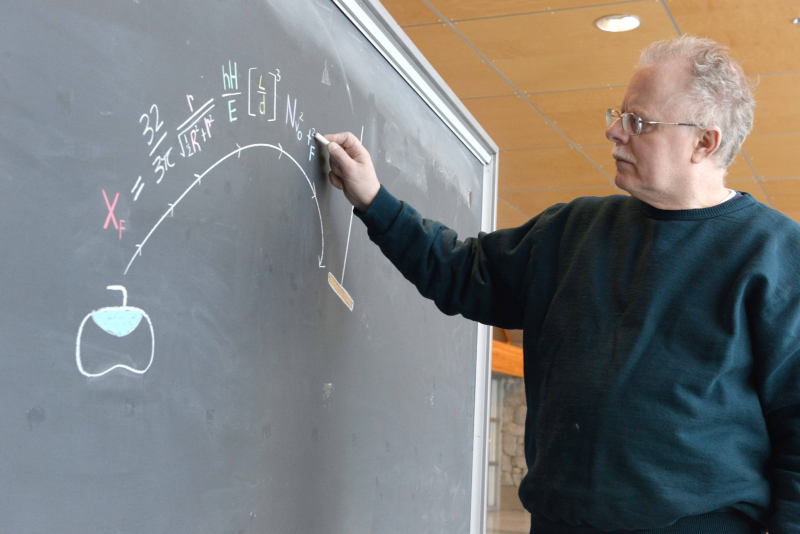Researchers Discover Why Curling Rocks Curl

Dr. Mark Shegelski was about as far away as he could get from a sheet of curling ice when he had a eureka moment that eventually led to a scientific breakthrough about how we understand the physics of the roaring game.
The UNBC Physics Professor was vacationing in Hawaii when it occurred to him a curling rock travelling down a sheet of ice may be momentarily sticking to the pebbled ice, causing repeated small pivots which leads to the gentle curve curlers use to get rocks around guards.
“I asked myself, ‘what’s the easiest way to change the direction of motion?’ ” Shegelski recalls. “I thought about it, and it occurred to me: if something sticks, you’ve changed the direction of motion.”
Shegelski did some initial calculations and determined the idea was feasible, but it took years of modelling and a collaboration with University of Alberta Earth and Atmospheric Sciences Professor Dr. Edward Lozowski for the pair to come up with a comprehensive formula that describes just what happens to the rock as it glides down the ice.
“Every single property of the motion is in that equation,” Shegelski says. “For physics, this is about as simple an expression as you can hope for.”
The formula, presented in a paper published in the journal Cold Regions Science and Technology earlier this year, takes into account the radii of the rock and the running band on the bottom of the rock, the size and density of the pebbles on the ice, the hardness and elasticity of the ice, the original speed of the stone when it was thrown and the time it takes for the rock to go down the sheet.
“This is a spectacular result,” Shegelski says. “This says that the rock can curl one metre.”
It even takes into account the effect of sweeping, which is used by curlers to keep rocks straighter and have them travel farther. The sweeping, according to the model, changes the hardness of the ice and therefore reduces the curl.
Vancouver Island University Physics Professor Dr. A. Raymond Penner was the first to suggest the curl might be due to a stick-slip effect in the late-1990s, but at the time no one was able to present a workable model. Shegelski read that paper at the time, but had long forgotten about the suggested concept when he started working with Lozowski on their stick-pivot-slide model.
“To understand some of these concepts has been notoriously difficult,” Shegelski says.
Shegelski, a former recreational curler, began his quest to solve the physics behind the sport in the mid-1990s. He made a lot of progress by the mid-2000s, but two big questions remained: Why did curling rocks curl a metre and why did the amount of rotation on the stones have little impact on the amount of overall curl?
He took a decade off from active research in the area, but still thought about the problem from time to time. It wasn’t until he was sitting down with his morning cup of coffee during a post-semester vacation that the idea of the rocks sticking to the ice struck him as a possibility worth exploring again.
He theorized that as the bond between the ice pebble and rock stretches, the rock pivots and when the bond inevitably breaks, the rock slides. The stick-pivot-slide cycle repeats itself thousands of times as the rock travels down the ice.
“Imagine if you draw all these really short lines and each of them is at a slightly different angle, what you are going to get is exactly what you see in a curling rink – a nice, curved path,” Shegelski says.
The second big break came after Shegelski returned home and he received a call from Lozowski who was beginning his own curling research and wanted to pick Shegelski’s brain. That sparked a fruitful collaboration. Shegelski brought his expertise in theoretical physics and his previous work on the physics of curling, which complemented Lozowski’s expert knowledge of the physics of ice.
“If each of us had worked on this alone, I don’t think we would have come up with this model,” Shegelski says. “But the combination of what he does and what I do, it just really worked. It was a really good collaboration.”
The pair wrote two papers, the first proposing the pivot-slide model and the second presenting the model.
The result is an equation that not only accurately describes the lateral motion of the rock, it also helps to answer the second observation Shegelski had spent years trying prove. The formula is able to predict the curl, without a term in the model representing the speed of rotation of the stone.
“If this is not the complete final answer, it certainly goes a long way towards it,” Shegelski says.
